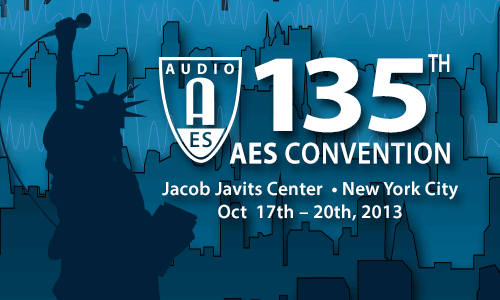AES New York 2013
Engineering Brief EB1
EB1 - Audio Processing
Thursday, October 17, 5:30 pm — 7:00 pm (Room 1E09)
Chair:
David Benson, McGill University - Montreal, Quebec, Canada; The Centre for Interdisciplinary Research in Music Media and Technology - Montreal, Quebec, Canada
EB1-1 Modeling the Korg35 Lowpass and Highpass Filters—Will Pirkle, University of Miami - Coral Gables, FL, USA
The Korg35 Filter is a voltage controlled Sallen-Key topology capable of producing both lowpass (LPF) and highpass (HPF) filter responses. It is known for its ability to self-oscillate as well as its saturated or distorted output as the damping factor of the filter approaches zero where self-oscillation occurs. Both LPF and HPF are second order but the highpass version features a 6 dB/octave roll off instead of the usual 12 dB/octave giving it a distinctive sound with more bass response. The analog Sallen-Key topology uses a delay-less positive feedback loop to implement the Q control of the filter. The saturation circuit is also inside this loop. Rather than use a typical biquad or state variable filter, we choose to use Virtual Analog (VA) filters [1] as building blocks to replicate the analog filter topology directly from its signal flow graph, including the delay-less loop as well as the saturation circuit. Both loaded and unloaded (lossy) versions of the Sallen-Key topology were designed and implemented in C++ with the point of self-oscillation exactly matching both analog transfer functions. Sample code and extra documentation are available at www.willpirkle.com.
Engineering Brief 103 (Download now)
EB1-2 Modeling the Harmonic Exciter—Priyanka Shekar, Stanford University - Stanford, CA, USA; Julius O. Smith, III, Stanford University - Stanford, CA, USA
A harmonic exciter is an audio effects signal processor applied to enhance the brightness and clarity of a sound, particularly used for vocals. This is achieved by inducing a measured amount of high-frequency distortion. In this paper an exciter is digitally modeled and implemented as a standalone application (or plugin) using the FAUST (Functional AUdio STream) programming language for real-time audio. The model is based on the Aural Exciter by Aphex Ltd., an analog hardware unit. Technical specifications of the Aural Exciter are drawn from the original 1979 patent. The digital model performs as expected, recreating a “intage" style audio effect.
Engineering Brief 104 (Download now)
EB1-3 Fourier Transforms, Audio Engineering, and the Quantum Nature of Reality—Scott Hawley, Dept of Chemistry & Physics, Belmont University - Nashville, TN, USA
A short interdisciplinary, educational survey is presented illustrating ways in which audio spectral analysis and quantum physics are intimately related. A basic conceptual understanding of Fourier transforms and their applications in audio engineering is sufficient to grasp aspects of quantum wave packets, the Heisenberg Uncertainty Principle, and more. Similarly, concepts from quantum mechanics can inform the understanding of audio effects such as aliasing, convolutions and wavelet transforms. The presenter is a computational physicist who authored a computer audio analysis suite for audio engineering students, noting several interdisciplinary connections in the process.
Engineering Brief 105 (Download now)
EB1-4 Experiments with Dither in Level-Calibrated Floating Point Audio Processing—Douglas Rollow, Sennheiser Technology and Innovation - San Francisco, CA, USA
The use of dither to decorrelate quantization error in fixed point signal processing systems is a well-established practice in professional audio. Floating point computation, however, is quite common due to the ease of use and ubiquity of high performance platforms, among other reasons. Dither is (anecdotally) less frequently found in floating point audio systems, until the final mapping to fixed point representation, but quantization error occurs in the rounding operation during intermediate calculations. Widrow and others have provided detailed treatment of the quantization error in floating point audio calculations, and in the present work experiments using dither during the internal rounding operation in a floating point unit are compared to the external addition of noise when the signal levels are known to be calibrated from the original analog source.
Engineering Brief 106 (Download now)
EB1-5 Virtual Development of Audio Systems—Application of CAE Methods—Alfred Svobodnik, Konzept-X - Karlsruhe, Austria
This paper will give an overview of state-of-the-art CAE methods for virtual product development of audio systems, especially focusing on automotive audio and small transducers. Matrix based CAE methods will be discussed to be used for multi-physical modeling of transducers, acoustic enclosures (e.g., doors or rear shelves of automobiles, or acoustic systems for phones) and listening spaces, especially automotive car cabins. Ultimately a process model allowing the simulation of complete systems, representing a fully virtualized product development environment, will be shown.
Engineering Brief 107 (Download now)
EB1-6 A New DSP Tool for Drum Leakage Suppression—Elias Kokkinis, accusonus - Patras, Greece; Alexandros Tsilfidis, accusonus, Patras Innovation Hub - Patras, Greece; Thanos Kostis, accusonus, Patras Innovation Hub - Patras, Greece; Kostas Karamitas, accusonus, Patras Innovation Hub - Patras, Greece
Microphone leakage is problem that sound engineers face every day. Leakage complicates audio editing, processing, and mixing, and it is a well known problem in drum recordings. To this day, sound engineers have only a limited amount of options available in order to address this problem. These mostly consist of simple and empirical methods. A novel technology that addresses the problem of microphone leakage in multichannel drum recordings is presented here. In addition we discuss the problem definition as deduced from the specific properties of drum recordings, as well as the resulting signal processing framework.
Engineering Brief 108 (Download now)
